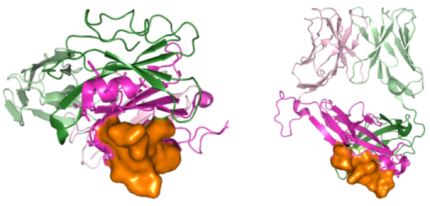Engineering of T-cell receptor for bispecificity
PRINCIPAL INVESTIGATOR: FLORIAN RÜKER
Background.
Understanding of anti-tumor immunity has increased significantly over the past decades, including fundamental insights into the role of innate and adaptive immunity in targeting and eradicating tumors. A crucial step for the targeting of tumors by cytotoxic T cells is the binding of T-cell receptors to peptides derived from the proteome of tumors and presented on the cell surface in the context of MHC Class I molecules. An effective T-cell immune response to target tumors is limited by central tolerance, where T cells with strong affinity for self-antigens are deleted in thymus, the natural selection process favoring growth of tumors with decreased antigen and MHC presentation (reduced density of peptide-MHC complexes), and peripheral tolerance mediated through host and tumor driven immunosuppressive mechanisms.
A validated method to implement the potent anti-tumor T-cell immunity is the ex vivo genetic modification of T-cells to target tumors through the use of affinity-enhanced receptors generated from either T-cell or antibody derived receptors, while another approach that does not require ex vivo manipulation of T-cells involves the use of fusion proteins that combine tumor recognition and T-cell engaging domains to redirect T-cells to target tumors. Several such reagents have already proved efficient in clinical evaluation. The use of antibody-based T-cell targeting reagents was restricted to targeting of antigens expressed on the cell surface until the development of bispecific reagents named ImmTACs, commercialized by the company Immunocore, which target proteosomally processed epitopes derived from intracellular, surface bound and secreted antigens. ImmTACs are comprised of soluble high affinity monoclonal TCRs (Li et al., 2005) specific for antigen-derived peptide-MHC complexes combined with an effector cell targeting scFv domain, which activates a potent anti-tumor T-cell response, and several candidates are currently undergoing Phase I/IIa clinical testing. In addition to driving redirected T-cell killing of tumor cells in vitro and in vivo, ImmTACs can induce and potentiate antigen cross-presentation by dendritic cells, but also other specialized antigen presenting cells, such as macrophages, which represent a higher proportion of tumor infiltrating immune cells.
The TCRs differ from antibodies in their poor stability and difficulty of expression, which is mirrored in the fact that until recently there were few crystal structures available despite their discovery over 30 years ago. The engineering of TCR molecules leading to reagents that can be applied in a TCR-based therapy involved modifications directed at increasing the stability and solubility of the molecule and at enhancing the affinity for antigen by directed molecular evolution of the antigen binding regions. Phage and yeast display systems of stability and solubility-enhanced TCR variants have been described (Holler et al., 2000) that allowed the display of scaffolds used in subsequent affinity maturation procedures, and extensive efforts have been invested in the optimization of the strategy of display in a single-chain format.

Aims and methods.
The main goal of the engineering would be the introduction of a second antigen binding site in the engineered constant domains of the T-cell receptor. As the T-cell receptor molecules are of low inherent stability, first steps will involve engineering of the yeast-displayed molecule for increased stability, followed by identification of positions tolerant to randomization required to introduce a binding site.
After the preparation of display libraries selection campaigns of clones specific for both targets will be performed, followed by expression of soluble bispecific TCR molecules and their extensive biophysical characterization. The nature of the novel target antigen will determine future characterization steps of the biological potential of the bispecific targeting agent. When aimed at bridging the immune synapse, the central question will be the optimization of parameters determining the contact between the target and the effector cell, such as valency and distance between the binding sites for both interaction partners. The ability of bispecific molecules to redirect effector cells to specifically kill their targets will be assessed in killing assays.
Methods will include: generation and selection of a TCR display library, mammalian cell expression, protein purification and characterization by size-exclusion chromatography, differential scanning calorimetry, binder characterization by ELISA, FACS, surface plasmon resonance and biolayer interferometry, and the evaluation of biological properties using cell-based assays and live-cell microscopy.
Holler, P. D., P. O. Holman, E. V. Shusta, S. O'Herrin, K. D. Wittrup, and D. M. Kranz, 2000, In vitro evolution of a T cell receptor with high affinity for peptide/MHC: Proc Natl Acad Sci U S A, v. 97, p. 5387-92.
Li, Y., R. Moysey, P. E. Molloy, A. L. Vuidepot, T. Mahon, E. Baston, S. Dunn, N. Liddy, J. Jacob, B. K. Jakobsen, and J. M. Boulter, 2005, Directed evolution of human T-cell receptors with picomolar affinities by phage display: Nat Biotechnol, v. 23, p. 349-54.
